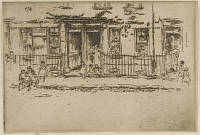Etchings Institutions search term: caxton club
Justice Walk, Chelsea | ||
| Number: | 441 | |
| Date: | 1888 | |
| Medium: | etching and drypoint | |
| Size: | 166 x 242 mm | |
| Signed: | butterfly at upper left | |
| Inscribed: | no | |
| Set/Publication: | no | |
| No. of States: | 2 | |
| Known impressions: | 4 | |
| Catalogues: | K.275; M.270 | |
| Impressions taken from this plate (4) | ||
KEYWORD
children, city, door, façade, people, street, woman standing.
TITLE
There are few variations on the title, for example:
'Justice Walk' (1886/1888, Whistler). 2
'Justice Walk - Chelsea' (1889, Whistler). 3
'Justice Walk, Chelsea' (1900, Caxton Club). 4
'Justice Walk, Chelsea' is the preferred title, based on that used by Whistler and later cataloguers.
'Justice Walk' (1886/1888, Whistler). 2
'Justice Walk - Chelsea' (1889, Whistler). 3
'Justice Walk, Chelsea' (1900, Caxton Club). 4
'Justice Walk, Chelsea' is the preferred title, based on that used by Whistler and later cataloguers.
DESCRIPTION
A view across a street to a row of houses with iron railings, drawn parallel to the edges of the plate. The ground floor is visible, and part of the windows in a semi-basement and those on the first floor. At far left is the side of a door, then two open sash windows with the sign 'C. W. BRETT / GARDINER' between them; then two adjoining open doors, the second with a woman standing in it, three small children in front of her; then two more sash windows, with plants in pots on the window sill. Finally, at right, there is another open door with women standing and talking. On the pavement at the left, there are several small children sitting or standing, and at the far right, two small children walking to right.
SITE
Justice Walk links Old Church Street and Lawrence Street in Chelsea, London. However, it was only being developed in the late 1880s (there was a Wesleyan Chapel but not much else), and it is not certain that the address is correct.
The sign that appears to read 'C. W. BRETT - GARDINER' may indicate that this was the premises of a gardener rather than that it belonged to two people, Brett and Gardiner.
It is possibly a coincidence, but there was an important gardener, Charles William Brett Tricker born in 1853. He was the son of Charles Tricker, a gardener. The family lived in Bishop Hortford, Hertford, Herts, just northeast of London. He was apprenticed at the Royal Botanic Garden, Kew, and emigrated to the United States in 1885, where he became a naturalized citizen in 1900. In the USA, he worked for several years as a gardener on a Staten Island estate and began experimenting with waterlilies. He established an aquatic nursery in Clifton, New Jersey, and issued his first catalogue in 1892. 5
5: Kit Knotts with Jim Lawrie, 'The Legacy of William Tricker', at http://www.victoria-adventure.org (accessed 2013).
DISCUSSION
This is one of many street scenes in Chelsea etched by Whistler, such as Fish-Shop, Chelsea
[267], Jubilee Place, Chelsea
[276], Bird-Cages, Chelsea
[297] and Perambulator, King's Road
[277].
Booth's map of the area shows that the inhabitants's income varied from very poor to reasonably comfortable, and in 1899, as Robins comments, 'The number of children aged between three and thirteen living in Justice Walk, 114, and Milman Street, 115, is astounding.' 6
Booth's map of the area shows that the inhabitants's income varied from very poor to reasonably comfortable, and in 1899, as Robins comments, 'The number of children aged between three and thirteen living in Justice Walk, 114, and Milman Street, 115, is astounding.' 6
6: Robins 2007 , pp. 131, 133; Charles Booth, ed., Life and Labour of the People of London, 2 vols., London, 1889, 1891; Life and Labour of the People of London with Maps, 9 vols., London, 1892-1897.

